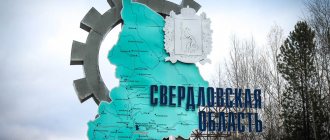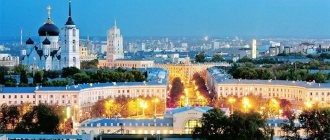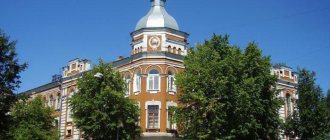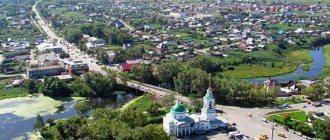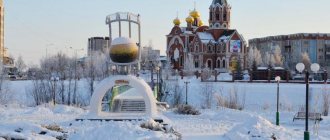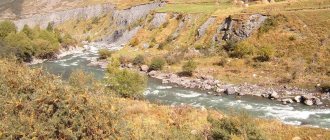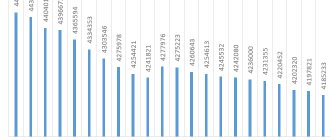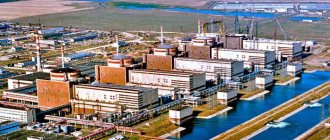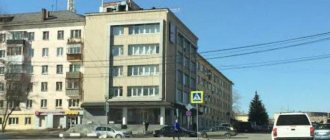The Sverdlovsk region is located on the border of Europe and Asia, in the zone of the northern and middle parts of the Ural Mountains, rich in minerals. It is natural resources that have become the basis for the development of the region and are the most important support for today’s economic development. In terms of size, the region is in 17th place in the all-Russian ranking: its area is 194,307 km². This is almost 4 times larger than the territory of the Moscow region and almost 16 times smaller than the area of the Republic of Sakha, the largest subject of the Russian Federation.
List of largest cities in the Sverdlovsk region
There are 47 cities and almost 1,850 small rural settlements in the Sverdlovsk region. However, there is only one metropolis - the capital of the region and the Urals Federal District, Yekaterinburg. Another 11 cities boast a size of more than 100 km², but in terms of population they lag significantly behind the million-plus city of Yekaterinburg, where 1,468,833 people live. The basis for the development of human settlements and their transformation in the course of history from small villages into large formations is industrial development based on the extraction and processing of minerals.
The largest cities in the Sverdlovsk region by area include:
- Ekaterinburg - 468 km².
- Serov - 418 km².
- Lesnoy - 360 km².
- Kachkanar - 317 km².
- Krasnoturinsk - 309 km².
- Zarechny - 299 km².
- Nizhny Tagil – 297 km²
- Verkhnyaya Tura - 236 km².
- Tavda - 148 km².
- Kamensk-Uralsky - 144 km².
What is the population in Yekaterinburg 2022?
Ekaterinburg is the largest city in the Urals; center of the Yekaterinburg agglomeration. One of the 15 millionaire cities in Russia. Population - 1,495,066 people. (2021).
Interesting materials:
How to choose Kalaud? How to choose a capacitor in a power supply? How to choose a men's belt? How are fragrances classified? How to trim wallpaper on the ceiling? How to calculate the cost of a lead? How to confirm a tag on a photo in a contact? How to confirm an account on MOS RU through government services? How to confirm an application in ATI? How does a starling sing sound?
Ekaterinburg is a metropolis and an industrial center of global importance
Yekaterinburg is the recognized capital of the Urals, the largest city in the region and the region, with an area of 468 km². It occupies fourth place in the list of the largest cities in Russia, second only to two capitals and Novosibirsk. Its urban agglomeration, which is also one of the three most successfully developing post-industrial ones, occupies the same position in the all-Russian ranking of the largest. In the capital of the region there are such important organizations as:
- Administration of the Urals Federal District;
- 35 authorities of various territorial affiliations;
- Presidium of the regional branch of the Russian Academy of Sciences;
- headquarters unit of the Central Military District.
Ekaterinburg plays a vital role not only in the Russian but also in the world economy; it is included in the ranking of 600 most important cities on the planet from an economic point of view, accounting for 60% of the global gross domestic product. Leading industry segments include:
- metallurgy;
- metal processing;
- military industrial complex;
- heavy engineering;
- chemical industry;
- food production;
- light industry;
- creation of optical, electronic and electrical equipment;
- printing;
- instrumentation and others.
There are about 220 significant enterprises in the city, most of which are engaged in the manufacturing industry. In second place in terms of contribution to the economy are retail trade enterprises, of which more than 4,000 are registered. In the capital of the Urals, there is Koltsovo Airport, and a branch of the Trans-Siberian Railway passes through the city. Public transport is well developed here: in addition to buses and minibuses, there are metro, trams and trolleybuses. In addition, the regional center is included in the list of ten Russian cities with the largest vehicle fleet. Such a developed transport infrastructure and industry cause serious harm to the environment. In terms of air pollution, Yekaterinburg is included in the all-Russian anti-rating. Despite the abundance of manufacturing enterprises, exhaust gases cause the greatest harm: they account for more than 90% of harmful emissions.
Yekaterinburg has given the world many talented and famous people. Among the most famous natives is Boris Yeltsin; one of the most visited city attractions, the Yeltsin Center, is also associated with his name. Also from here are the storyteller Bazhov, singer Yuri Gulyaev, and the legendary rock groups Nautilus, Chaif and Agatha Christie. The local theaters are considered one of the best, and museums present a variety of exhibitions: from the history of literature to an amazing collection of minerals.
Description of the region
The Sverdlovsk region is a subject of the Russian Federation, part of the Ural Federal District. It borders with the Perm Territory, Khanty-Mansi Autonomous Okrug, the Komi Republic, Tyumen, Chelyabinsk, Kurgan regions, and Bashkotorstan. The administrative center is Yekaterinburg, which was formerly called Sverdlovsk. Hence the name of the region itself. The border between Europe and Asia runs near Yekaterinburg.
This is the largest region of the Urals. The area of the Sverdlovsk region is almost 200 thousand square kilometers. The territory includes the north of the Ural Mountains and part of the West Siberian Plain.
The climate in the region is continental. Summers are hot, with temperatures up to 30 degrees Celsius, winters are moderately cold. In January - on average -17-20 degrees. The territory is mainly covered with forests, 82 percent of them.
Serov is a large production center
Serov is only in fifth place in terms of population with 97,366 inhabitants, but in terms of area it ranks second with 418 km². Like the leader of the rating, it is an important center of industry, thanks to the development of which it gained life. It is believed that more than a thousand years ago there was a settlement of the Mansi, the indigenous local population, on this territory. Over time, Russians began to move into the region, having discovered rich mineral deposits, and the Mansi left the region, moving to the northern lands.
In 1894, a settlement was founded in these places, designed to meet the needs of large-scale construction: for the production of steel rails, a plant was built, which was named Nadezhdinsky: later the entire expanded village began to be called that. As a result, in 1919 it received city status, and twenty years later it was renamed in honor of the hero of the USSR Anatoly Serov. The city's economy is formed by the engineering and metallurgical industries. The city-forming enterprises include:
- "Nadezhda Metallurgical Plant" (named after Serov);
- Serov Mechanical Plant - production of industrial tools;
- The Serov Ferroalloy Plant is the second largest in terms of production volume after an enterprise in the same segment from Chelyabinsk.
Story
The first Russian settlement on the territory of modern Yekaterinburg is considered to be the village of Shartash, founded by Old Believers in 1672 on the shore of the lake of the same name. In 1704, on the Uktus River (now called Patrushikha), the state-owned Uktus Plant was founded - one of the first metallurgical plants in the Urals.
By order of Peter I, V.N. arrived in the Urals in 1720 as the head of state-owned mining factories. Tatishchev. He came to the conclusion that it was necessary to create an industrial and commercial center in the Urals. He chose a place for him on the Iset River, but after that Tatishchev was recalled from the Urals due to denunciations.
William de Gennin arrived in the Urals. At the site chosen by Tatishchev, Gennin built the Yekaterinburg plant, which was launched on November 18, 1723. This date is considered the birthday of Yekaterinburg. The city got its name in honor of the wife of Peter I, the future Empress Catherine I. Gennin wrote:
“... a new fortress, which was built in the Ugric province near the Iset River, and in it factories with various factories and manufactories, was named after Yekaterinburg, for the memory of eternal generations and for the eternal glory of Her Majesty, the most merciful Empress.”
Since times were turbulent, the city was located inside a wooden fortress. In 1735, the Mint was created in Yekaterinburg, which worked intermittently until 1876.
Monument to the founders of the city - V.N. Tatishchev and V. de Gennin
At that time, the Ekaterinburg plant was the largest in the Urals. But since it stood on a very small river, there was often not enough water to operate the enterprise. To avoid plant shutdowns, another dam was built upstream of the Iset, and next to it the Verkh-Isetsky plant. Later, in the vicinity of Yekaterinburg, the Elizavetinsky and Nizhne-Isetsky factories were built, the territory of which eventually became part of the city.
Since the late 1750s, production output at the Yekaterinburg plant gradually decreased. Copper smelting production ceased in 1769, and the plant was closed in 1808.
In 1765 (according to other sources, in 1751) the Yekaterinburg lapidary factory was founded, which later became famous. Its heyday occurred in the mid-19th century. The city was one of the world centers for the artistic processing of colored stone. Products made here from Ural stone were used to decorate imperial palaces; now they can be seen in the Hermitage in St. Petersburg and in other large museums.
Yekaterinburg city. Photo by V.L. Metenkova
Yekaterinburg developed as an administrative center of the mining industry of the Urals and Siberia. In 1781, Yekaterinburg received the status of a district city of the Perm province, and in 1807 - the status of a “mountain city” equal to a provincial one. Here was the residence of the Chief Director of the mining factories of the Ural ridge. In 1863 the city became a civil department.
Trade developed rapidly, there were many merchants. In the 1820s, Yekaterinburg and its environs were gripped by a gold rush. Many merchants made a fortune from this. As a reminder of those times, some luxurious merchant mansions have been preserved in the city.
The Great Siberian Highway, which passed through Yekaterinburg in the 1760s, also contributed to the development. In 1878, the first Ural mining railway in the region was built, and later others. The city grew and developed quickly. In 1887, a large Siberian-Ural scientific and industrial exhibition took place here, which at that time was a big event.
Old railway station
By the beginning of the 20th century, Yekaterinburg became one of the largest district centers in Russia. The Ural Chemical Laboratory, the Siberian Trade Bank, branches of almost all major banks in the country worked here, and 49 factories and factories operated. By 1917, about 100 thousand people lived in Yekaterinburg. Despite the active development of the city, it did not have a developed infrastructure; water supply appeared in it only in Soviet times.
Archiereiskaya Street
During the Civil War, on July 17, 1918, the last Russian Emperor Nicholas II and his family were shot in the basement of Ipatiev’s house in Yekaterinburg.
Since 1918, Yekaterinburg became the center of the Yekaterinburg province. With the arrival of the whites it was abolished and then restored again. In 1923, Yekaterinburg became the capital of the huge Ural region, which included the territories of modern Kurgan, Chelyabinsk, Tyumen, Sverdlovsk regions and the Perm region. On October 14, 1924, the city was renamed Sverdlovsk - in honor of the revolutionary Ya.M. Sverdlova (1885–1919). On January 17, 1934, the Sverdlovsk region was separated from the Ural region.
During the first five-year plans, Sverdlovsk turned into a powerful industrial center. In the 1930s, Uralelectromash and others were built. In addition to industry, science and education developed. In 1932, the Ural Branch of the Academy of Sciences opened. During the Great Patriotic War, more than 50 large enterprises were evacuated to the city, on the basis of which new factories were created or old factories were expanded.
During Soviet times, the appearance of Sverdlovsk changed dramatically. It was rebuilt by talented architects in new architectural styles.
On September 4, 1991, the city returned its historical name, but the Sverdlovsk region retains its former name to this day.
The building of the mountain pharmacy (now the museum of stone-cutting art)
Among the tragic events in the history of the city, it is worth noting the anthrax epidemic that broke out due to the military in the spring of 1979, as well as the powerful explosion at the Sverdlovsk-Sortirovochny station on October 4, 1988.
At different times, many famous people lived in the city: writers D.N. Mamin-Sibiryak, P.P. Bazhov, V.P. Krapivin, inventor of radio A.S. Popov, military leader G.K. Zhukov, Secretary General L.I. Brezhnev, the first president of Russia B.N. Yeltsin and others.
Water tower
Lesnoy is a large city located in a closed area
Surprisingly, the third largest city of Lesnoy with an area of 360 km² is only on the 13th place in the list of the largest cities by the number of inhabitants. This is explained simply: the formation is a closed territory, since the Elektrokhimpribor plant, which works with uranium, is located here. The factory and then the settlement were built by Gulag prisoners. In the first years of its existence, it was called Sverdlovsk-45: only in 1994 the name was renamed.
In this regard, there are no significant attractions in Lesnoy, but the infrastructure for local residents is well developed. There are about 500 companies in various segments of the economy, as well as 3 universities, among which there is one that corresponds to the profile of the city - a branch of the Scientific Research Nuclear University MEPhI.
Kachkanar is large in area, but not in numbers
Kachkanar ranks fourth in area - 317 km², and fifteenth in number of inhabitants - 38,996 people. Like many others in the region, it arose in the 19th century thanks to the wealth of the Ural mineral resources: platinum and gold were discovered nearby.
This led to the emergence of many mining settlements. On the basis of one of them, in the fifties of the last century, a village appeared, created for workers of the Kachkanar group of iron ore deposits. The formation of the Kachkanarsky mining and processing plant occurred during the same period: the enterprise, declared an all-Union construction site, today acts as a city-forming enterprise. Kachkanar gives the impression of a well-groomed, clean and green town. Most of the attractions are monuments and memorials, including those to the Liquidators of Nuclear Disasters, as well as the heroes of the Second World War and the Afghan War. Some of the most beautiful buildings are the Old and New Temples of the “Seeking the Lost” icon.
